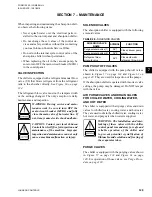
JOHNSON CONTROLS
143
SECTION 7 – MAINTENANCE
FORM 155.30-ICOM2.EN.UL
ISSUE DATE: 12/21/2018
7
WATER QUALITY CONTROL
Use the following guidelines to be sure of the highest
water quality control standards:
• Limit the water pressure to the maximum safe
working pressure for chilled, cooling, and hot wa-
ter.
•
Install a 10-20 or finer mesh strainer in the chilled,
cooling, and hot water piping.
• Install a thermometer and a pressure gauge in the
inlet and the outlet of the chilled, cooling, and hot
water piping.
• Install tapping (with valve) for chemical cleaning
of the inlet and the outlet of the chilled, cooling,
and hot water piping.
• Install an air vent valve at the highest part of the
piping and a drain valve at the lowest part of the
piping.
• Replace the water regularly and control the water
quality. Operating the chiller for long periods of
time with low quality water will cause corrosion
and the production of scale.
• When the chiller starts, the hot water return tem-
perature tends to drop temporarily. If it affects the
heat source, be sure to prepare a heat storage tank,
and other necessary components.
• Make sure the shut off valves installed at the chill-
er inlet of the chilled, cooling, and hot water are
completely open.
NOTE: If the chiller runs without the
valves completely open, a strong turbulent
flow can be generated. The turbulence may
cause damage in the water chamber case
and the copper tube of the chiller. If you
need to adjust the flow rate of the chilled
water and the cooling water, be sure to
adjust the valves installed at the outlet side
of the chiller.
• Install a safety valve on the hot water line.
• Install an expansion tank on the hot water line if
the hot water is a closed system.
CHEMICAL WATER TREATMENT
Since the mineral content of the water circulated
through the evaporator, condenser, absorber, and gen-
erator varies, the water used may corrode the tubes or
deposit heat resistant scale in them.
Perform a chemical analysis of the water before the
system is installed. Consult a reliable water treatment
company to determine if treatment is necessary. If it
is, the company can provide treatment for the water to
help prevent damage to the tubes.
REPLACEMENT OF WATER
Since the cooling water system can be polluted by vari-
ous factors, it must be cleaned and the water it in must
be replaced periodically. Generally, if the water is not
treated at all by the cooling tower, the recommended
interval to replace the cooling water is:
• District polluted with sulfurous acid gas --- 5 days
• Common district --- 10 days
If the water is blown manually or automatically, the
replacement period may be lengthened as follows.
• District polluted with sulfurous acid gas --- 1
month
• Common district --- 1 month
TREATMENT FOR LONG STOPPAGE OF THE
ABSORPTION CHILLER
If the absorption chiller is stopped for a long time, bac-
teria in the water or in the tubes may grow. The bacteria
can corrode the tubes. When stopping the chiller for
more than 15 days, drain the water from the absorber,
condenser, evaporator, and the generator through the
drain valve at the bottom of the waterbox.
CHEMICAL TREATMENT
Corrosion inhibitors are attracted chemically to corrod-
ed metal surfaces. Or, they form inert protective com-
pounds over the metal surfaces. For effective use of the
corrosion inhibitors, be sure to choose the correct type
and concentration. Water quality, temperature, flow
speed, metals used, existence of crevices and deposits
and type of water system are also part of the equation.
For more information about corrosion preventive mea-
sures, consult a water treatment company.






























